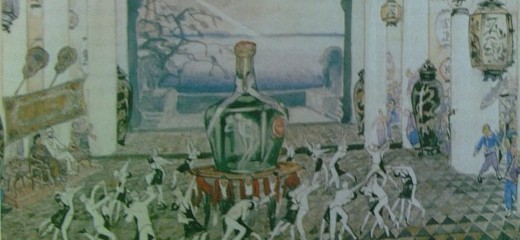
The Red Poppy, scenery by M. Kurilko
Turbulent Times in Motion
by Lynn Matluck Brooks
Just how intimate are politics and art? They are utterly intertwined, interpenetrating, interdependent. So I realized upon attending this weekend’s symposium, “Russian Movement Culture of the 1920s and 1930s,” at the
Harriman Institute of Columbia University. The intense three days of papers, films, discussions, and conversations revealed a period of extraordinary vibrancy in Russia and in the émigré populations that landed, often in swarms, in European capitals and in cities from Buenos Aires to New York to Sydney.
Following upon the centenary of the
Rite of Spring premiere, celebrated in 2013, excitement about the vibrancy of Russian art, music, and dance of the early twentieth century continued to percolate. Stimulated by the flurry of 2013 publications, exhibitions, and performances,
Lynn Garafola, Barnard College professor and prolific dance historian, joined with
Catharine Nepomnyashchy, chair of Barnard’s Slavic Department, to organize the Harriman Institute symposium. The presenters were drawn from among the best dance scholars around the world, representing France, Germany, Israel, Italy, Russia, and the United States. Each presented an exhaustively researched paper, often beautifully illustrated, on topics grouped into four categories: “Making the New Soviet Body,” “A New Soviet Ballet,” “The Problematic Career of Serge Lifar,” and “Èmigré Bodies.” Simon Morrison of Princeton University presented the fascinating keynote, “How the Bolshoi Ballet Survived the Revolution,” which laid the groundwork for the complexities of the histories and personal stories that the symposium presenters brought so effectively to light.
Although some of these remarkable scholars seemed unable to project their voices or adjust to the microphone so that they could be heard in the small and crowded symposium room, the attention required to catch each word was richly rewarded. Moments of epiphany occurred: Nicoletta Misler’s paper on Isadora Duncan and the Russian avant-garde was followed by scholar Irina Sirotkina’s comment, before presenting her paper on “Choreographing Physical Culture,” that she herself is a fourth-generation Duncan dancer, trained in the Geptakhor school of movement founded by Isadora’s followers in St. Petersburg. The panel on Serge Lifar exposed to painstaking analysis that artist’s literary, political, aesthetic, and social history—a scrutiny most chillingly revealed in Mark Franko’s contribution, “The Politics of Serge Lifar,” which substantiated allegations against Lifar as a collaborator with the Nazi occupiers of Paris.
The rich artistic experimentation following the Russian Revolution—itself a complex intermixture of civil war and coup d’etat—was another revelation to me. In the forming of the “new Soviet man,” dancers jumped headlong (almost literally, in their acrobatism) into the fray, some seeking to abandon ballet and others to reform it, some to make dance muscular and others to make it musical, some to bring high art to the masses and others to bring popular arts to formerly elitist institutions like the Bolshoi Ballet. The ever-shifting political ground following the revolution could cause an artist’s work to be lionized one day and eviscerated the next, with unpredictable and often dire consequences for the artist. This was particularly true, noted Christina Ezrahi in her paper on “Experiments in Character Dance,” as the “darkness descended” with Stalin’s rise to power in the mid-1920s. Works seemingly tailor-made for Soviet expression—like Vasili Vainonen’s Partisan Days (1936-37) or the earlier Red Poppy (explored by Edward Tyerman in his presentation on this 1927 work), fell afoul of official critics.
Those who fled the Soviet state often established vibrant émigré communities, especially in metropolises like Paris and Berlin. Their contributions to the creative ferment in these cities shaped all the arts—none more so than dance, be it ballet, modern dance, or music-hall varieties. The Ballets Russes and its successors, and smaller, shorter-lived companies, brought modernism to stages worldwide, and penetrated opera, cabaret, and film (a fascinating paper by Daria Khitova explored “Nijinsky’s Afterimages in Eisenstein’s and Chaplin’s Eyes”). Yet some of the greatest artists, like Bronislava Nijinska (as revealed in Lynn Garafola’s presentation on that dancer and choreographer in the 1920s and ’30s) remained forever alienated and suffering as they lost their national moorings irrevocably. Speaker after speaker revealed deeply sad stories of dance artists who wandered amid the bewildering political, social, and aesthetic movements of the age.
Dance itself was also on view in the course of this symposium. Three sessions of film-viewing presented footage on the themes “Dancing in Soviet Russia,” “Alexei Ratmansky’s Recreations of Bolt [1931, music by Dimitri Shostakovich, choreography by Fyodor Lopukhov] and Flames of Paris [1932, m. Boris Asafyev, ch. Vasily Vainonen],” and “Dancing in ‘Russia Abroad.’” In the first set of films, we watched clips of such luminaries as Asaf Messerer, Natalia Dudinskaya, Vakhtang Chabukiani, Galina Ulanova, and Maya Plisetskaya. In the final set, footage featured a number of early Balanchine works, among others, and dancing by Irina Baronova, Tamara Toumanova, Léonide Massine, Vera Zorina, Lew Chistensen, and even Walt Disney’s hippos.
I regret that space doesn’t permit my mentioning every presenter and paper in this three-day event, so profoundly satisfying to my dance-historian soul. I was nourished not only by the generous trays of pastries and fruit provided by the Harriman at each session, but more especially by the exceptionally high quality of the presenters, the discussants’ trenchant and unifying remarks, the insightful questions posed by an audience filled with cognoscenti, and the focus that deepened and broadened my understanding of this complex, fruitful, and disturbing period—a period in turbulent motion.
"Russian Movement Culture of the 1920s and 1930s," Columbia University, Harriman Institute, February 12-14.
By Lynn Matluck Brooks
February 15, 2015

